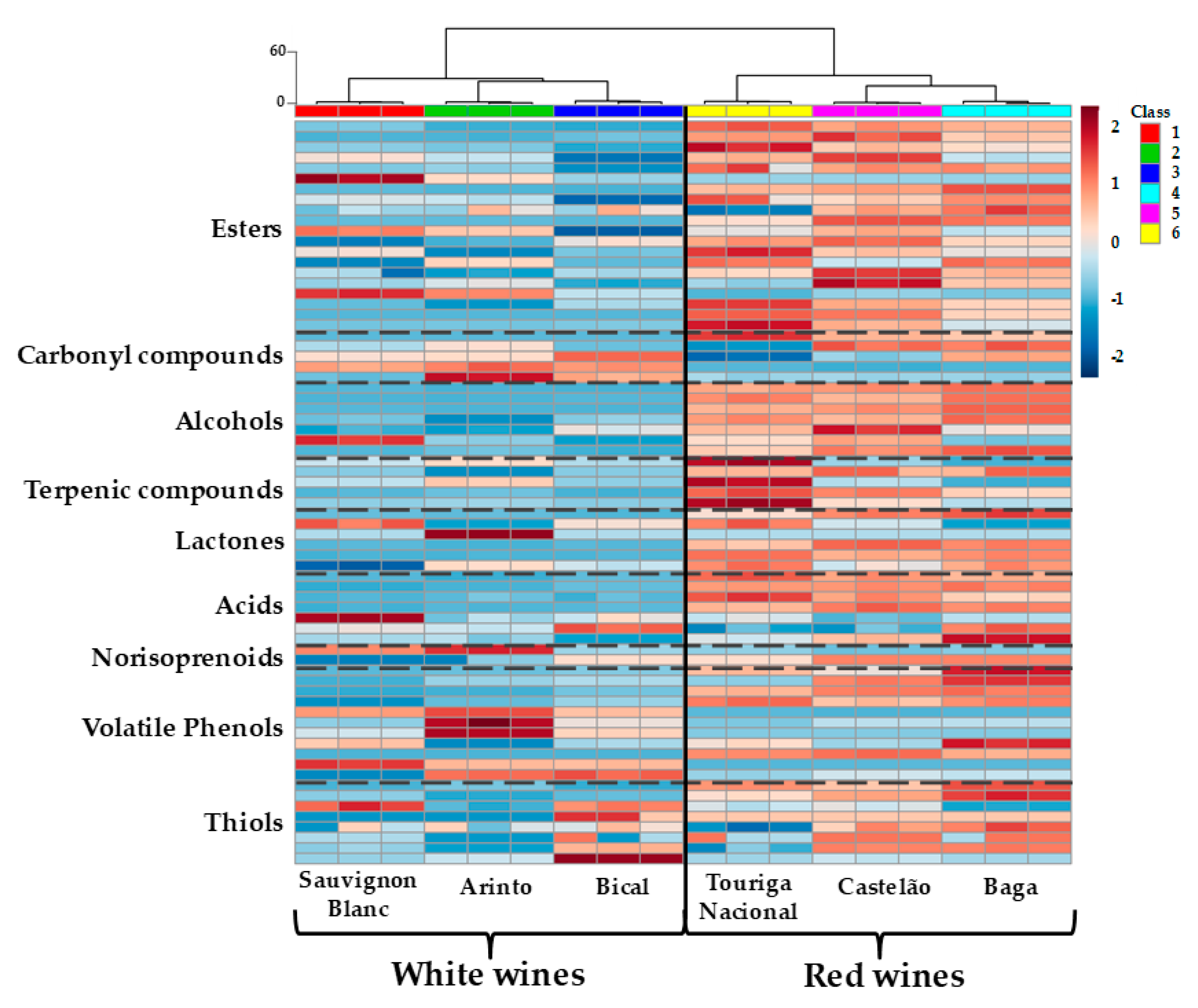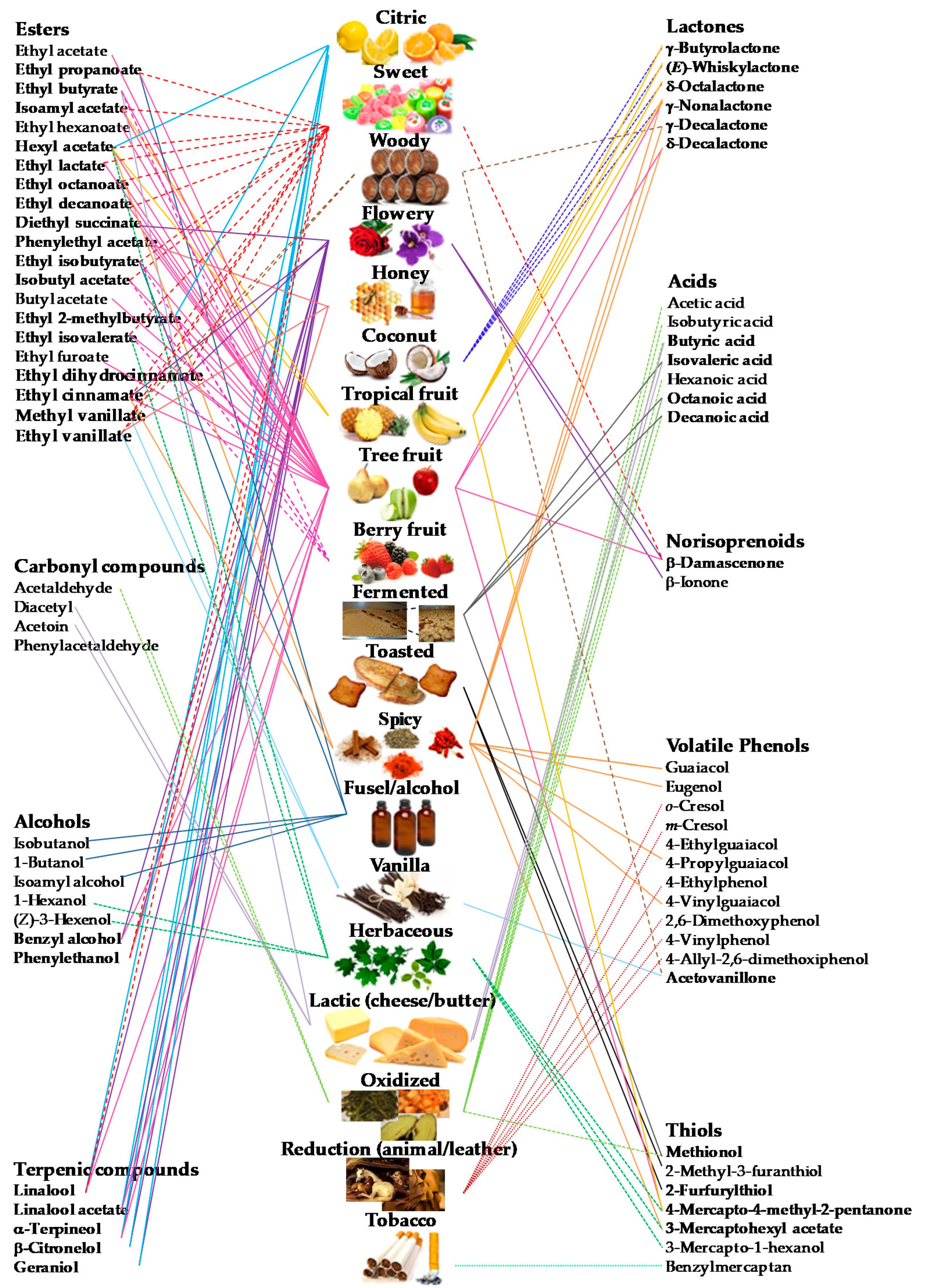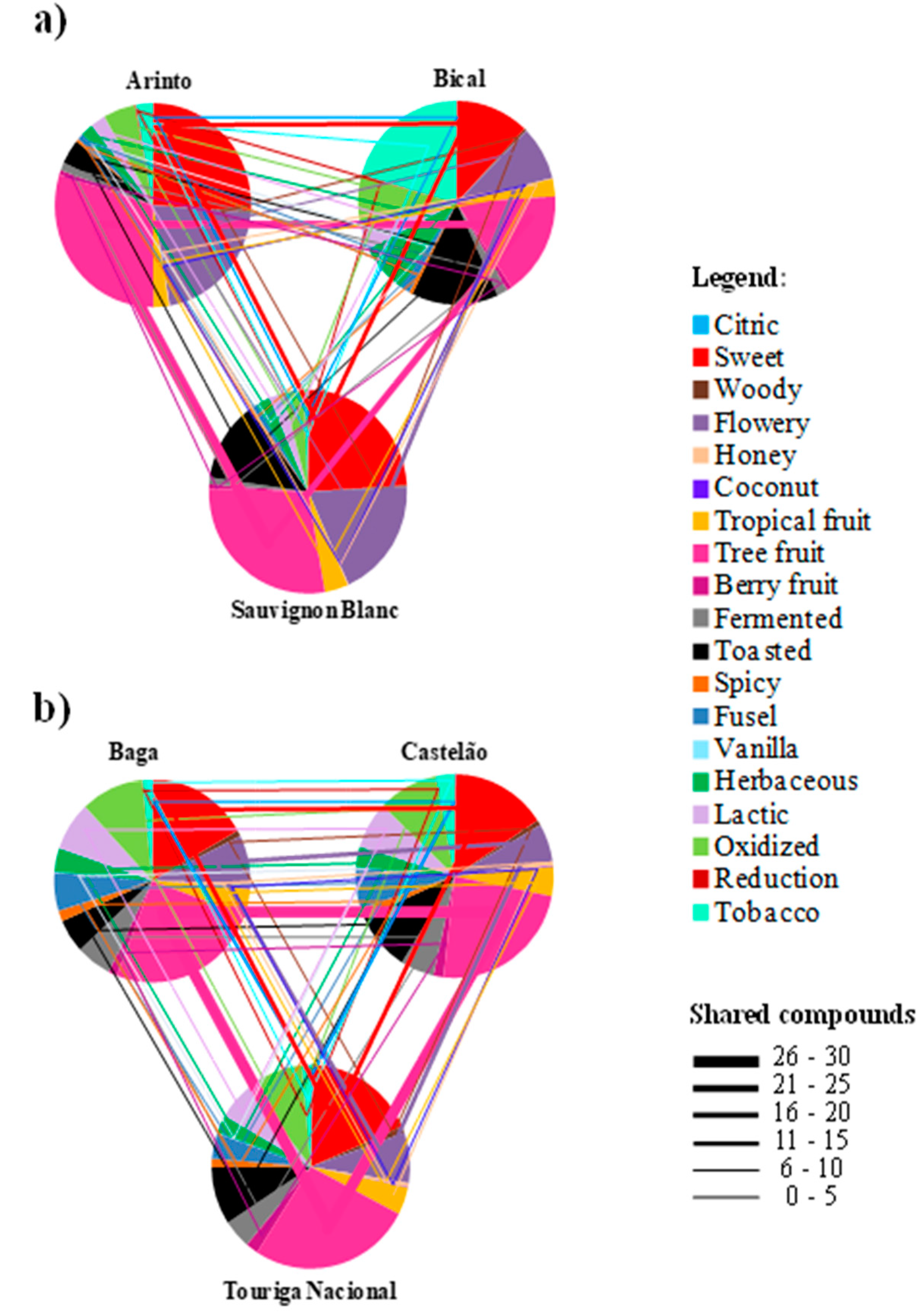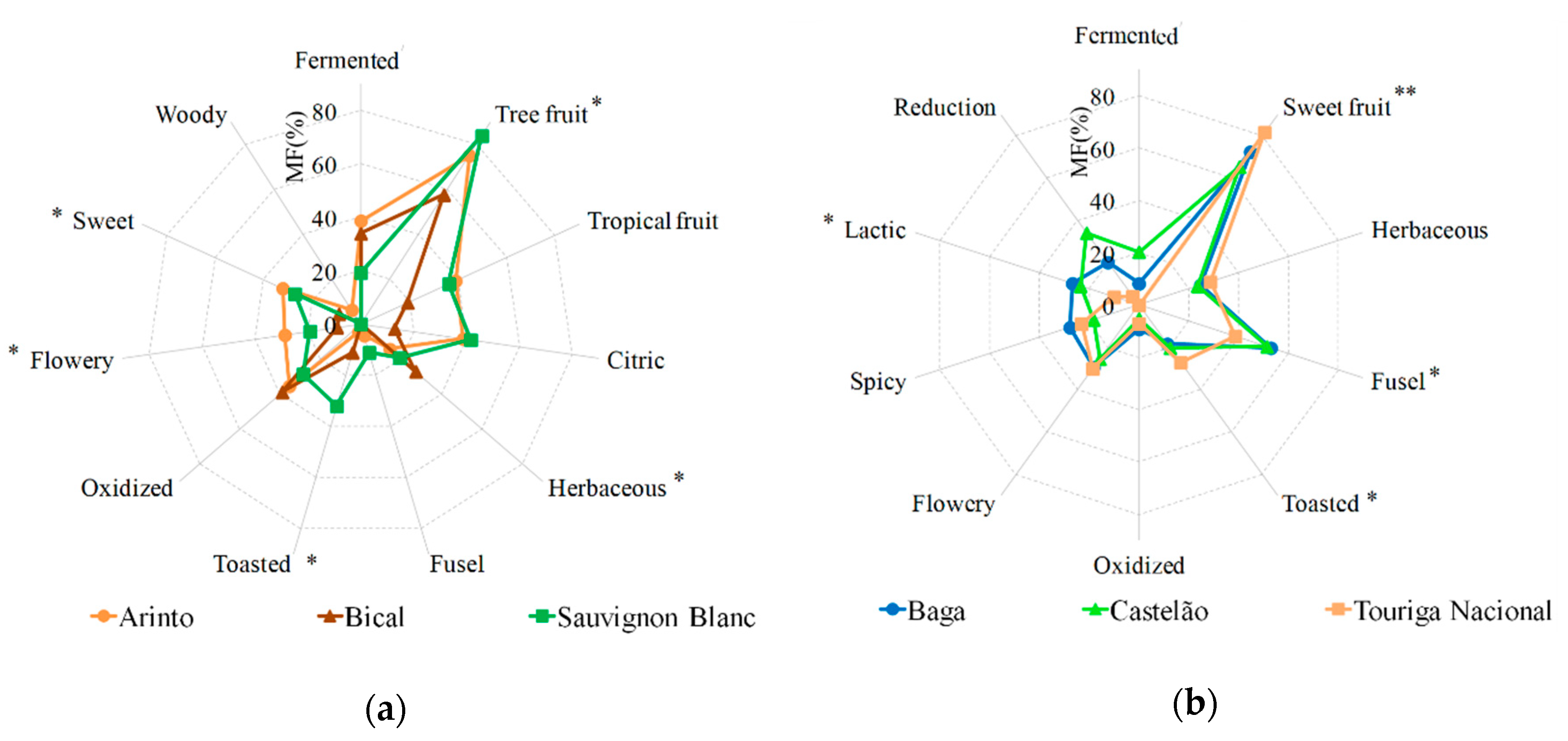Revealing the Usefulness of Aroma Networks to Explain Wine Aroma Properties: A Case Study of Portuguese Wines
Abstract
:1. Introduction
2. Results and Discussion
2.1. Volatile Components Determination by GC-Based Techniques
2.2. Aroma Network Approach for Wine Aroma Fingerprint
2.2.1. Wine Aroma Network Construction
2.2.2. Aroma Fingerprint of the Six Monovarietal Wines
Sauvignon Blanc Wine
Arinto Wine
Bical Wine
Baga Wine
Castelão Wine
Touriga Nacional Wine
2.2.3. New Insights from Aroma Network Analysis
2.3. Aroma Sensory Analysis
3. Materials and Methods
3.1. Wines Under Study
3.2. Reagents and Standards
3.3. Determination of Wine Volatile Components Based on Gas Chromatographic Techniques
- Determination of terpenic compounds, lactones, C13 norisoprenoids, volatile phenols, and also some esters, alcohols, and acids was done by solid-phase extraction (SPE)/GC–ion trap–mass spectrometry (MS). According to the previously developed SPE/GC–ion trap–MS methodology [39], 50 mL of wine sample containing 26 μL of surrogate standards solution (isopropyl propanoate, 3-octanone, heptanoic acid, and β-damascone) were passed through a SPE LiChrolut EN cartridge and the retained wine volatile components were eluted with 1.6 mL of 1% methanol dissolved in dichloromethane. Then, an internal standard solution (2-octanol, 4-methyl-2-pentanol, and 4-hydroxy-4-methyl-2-pentanone in dichloromethane) was added to the eluted sample. The extract (3 μL) was then analyzed by GC with ion trap–MS, scanning the range 35–300 m/z in a full scan acquisition mode. Identification of each volatile compound was confirmed by the coincidence of the retention times and mass spectra of each compound with the corresponding chemical standard. Quantitative data were obtained by interpolation of relative peak areas in the calibration graphs obtained from the GC–MS of dichloromethane solutions containing known amounts of the analytes.
- Determination of thiols was done using SPE/GC–negative chemical ionization (NCI)–MS. Based on the developed SPE/GC–NCI–MS methodology for the determination of thiols [40], a vial with 25 mL of wine, 0.2 g of ethylenediaminetetraacetic acid disodium salt 2-hydrate (EDTA) (5 g/L), and 0.6 g of L-cysteine clorhydrate (0.1 M Cys) was shaken for 2 min. After this, 15 μL of an ethanolic solution containing the internal standard (1.4 ng/L of 2-phenylethanethiol) was added and shaken to ensure complete dissolution. Then, 0.2 g of O-methylhydroxylamine was added to the sample and incubated (55 °C, 45 min). After this, 6 mL of the incubated sample was loaded onto a Bond Elut-ENV SPE cartridge. Then, a second internal standard was also loaded into the cartridge (20 μL of an ethanolic solution containing 150 μg/L of 4-methoxy-α-toluenethiol and 200 μL of water). The thiols retained in the SPE cartridge were directly derivatized by passing 1 mL of an aqueous solution of 1,8-diazabicyclo[5.4.0]undec-7-ene (DBU) (6.7%) and 50 μL of a 2 μg/L solution of 2,3,4,5,6-pentafluorobenzyl bromide (PFBBr) in hexane. Derivatized analytes were eluted with 600 μL of hexane/diethylether (25%), and then an internal standard (1,4-dithioerythritol octafluoronaphthalene (OFN), 22.5 μg/L) was added. This extract (4 μL) was directly injected into the GC–NCI–MS system and the analytes were acquired in single ion monitoring (SIM) mode.
3.4. Wine Aroma Sensory Analysis
3.5. Data Processing
4. Concluding Remarks
Supplementary Materials
Author Contributions
Funding
Conflicts of Interest
References
- Hopfer, H.; Heymann, H. Judging wine quality: Do we need experts, consumers or trained panelists? Food Qual. Prefer. 2014, 32, 221–233. [Google Scholar] [CrossRef]
- Saenz-Navajas, M.; Campo, E.; Sutan, A.; Ballester, J.; Valentin, D. Perception of wine quality according to extrinsic cues: The case of Burgundy wine consumers. Food Qual. Prefer. 2013, 27, 44–53. [Google Scholar] [CrossRef]
- Ayestarán, B.; Martínez-Lapuente, L.; Guadalupe, Z.; Canals, C.; Adell, E.; Vilanova, M. Effect of the winemaking process on the volatile composition and aromatic profile of Tempranillo Blanco wines. Food Chem. 2019, 276, 187–194. [Google Scholar] [CrossRef] [PubMed]
- Rodrigues, H.; Sáenz-Navajas, M.P.; Franco-Luesma, E.; Valentin, D.; Fernández-Zurbano, P.; Ferreira, V.; De La Fuente Blanco, A.; Ballester, J. Sensory and chemical drivers of wine minerality aroma: An application to Chablis wines. Food Chem. 2017, 230, 553–562. [Google Scholar] [CrossRef] [PubMed] [Green Version]
- Rice, S.; Tursumbayeva, M.; Clark, M.; Greenlee, D.; Dharmadhikari, M.; Fennell, A.; Koziel, J. Effects of Harvest Time on the Aroma of White Wines Made from Cold-Hardy Brianna and Frontenac Gris Grapes Using Headspace Solid-Phase Microextraction and Gas Chromatography-Mass Spectrometry-Olfactometry. Foods 2019, 8, 29. [Google Scholar] [CrossRef] [Green Version]
- Saha, B.; Longo, R.; Torley, P.; Saliba, A.; Schmidtke, L. SPME Method Optimized by Box-Behnken Design for Impact Odorants in Reduced Alcohol Wines. Foods 2018, 7, 127. [Google Scholar] [CrossRef] [Green Version]
- Lyu, J.; Ma, Y.; Xu, Y.; Nie, Y.; Tang, K. Characterization of the Key Aroma Compounds in Marselan Wine by Gas Chromatography-Olfactometry, Quantitative Measurements, Aroma Recombination, and Omission Tests. Molecules 2019, 24, 2978. [Google Scholar] [CrossRef] [Green Version]
- Zhang, Y.-S.; Du, G.; Gao, Y.-T.; Wang, L.-W.; Meng, D.; Li, B.-J.; Brennan, C.; Wang, M.-Y.; Zhao, H.; Wang, S.-Y.; et al. The Effect of Carbonic Maceration during Winemaking on the Color, Aroma and Sensory Properties of ‘Muscat Hamburg’ Wine. Molecules 2019, 24, 3120. [Google Scholar] [CrossRef] [Green Version]
- Ferreira, V. Volatile aroma compounds and wine sensory attributes. In Managing Wine Quality, 1st ed.; Reynolds, A., Ed.; Woodhead Publishing Limited, CRC Press LLC: Boca Raton, FL, USA, 2010; Chapter 1; Volume 1, pp. 3–28. [Google Scholar] [CrossRef]
- Alvarez, M.; Gonzalez-Barreiro, C.; Cancho-Grande, B.; Simal-Gandara, J. Relationships between Godello white wine sensory properties and its aromatic fingerprinting obtained by GC-MS. Food Chem. 2011, 129, 890–898. [Google Scholar] [CrossRef]
- Miras-Avalos, J.; Bouzas-Cid, Y.; Trigo-Cordoba, E.; Orriols, I.; Falque, E. Effects of Two Different Irrigation Systems on the Amino Acid Concentrations, Volatile Composition and Sensory Profiles of Godello Musts and Wines. Foods 2019, 8, 135. [Google Scholar] [CrossRef] [Green Version]
- Robinson, A.; Adams, D.; Boss, P.; Heymann, H.; Solomon, P.; Trengove, R. The relationship between sensory attributes and wine composition for Australian Cabernet Sauvignon wines. Aust. J. Grape Wine Res. 2011, 17, 327–340. [Google Scholar] [CrossRef]
- Vilanova, M.; Genisheva, Z.; Masa, A.; Oliveira, J. Correlation between volatile composition and sensory properties in Spanish Albarino wines. Microchem. J. 2010, 95, 240–246. [Google Scholar] [CrossRef]
- Ferreira, V.; Saenz-Navajas, M.; Campo, E.; Herrero, P.; de la Fuente, A.; Fernandez-Zurbano, P. Sensory interactions between six common aroma vectors explain four main red wine aroma nuances. Food Chem. 2016, 199, 447–456. [Google Scholar] [CrossRef] [PubMed]
- Ahn, Y.-Y.; Ahnert, S.E.; Bagrow, J.P.; Barabási, A.-L. Flavor network and the principles of food pairing. Sci. Rep. 2011, 1, 196. [Google Scholar] [CrossRef]
- Callejon, R.M.; Clavijo, A.; Ortigueira, P.; Troncoso, A.M.; Paneque, P.; Morales, M.L. Volatile and sensory profile of organic red wines produced by different selected autochthonous and commercial Saccharomyces cerevisiae strains. Anal. Chim. Acta 2010, 660, 68–75. [Google Scholar] [CrossRef]
- Martins, C.; Brandao, T.; Almeida, A.; Rocha, S.M. Unveiling the lager beer volatile terpenic compounds. Food Res. Int. 2018, 114, 199–207. [Google Scholar] [CrossRef]
- Campo, E.; Ferreira, V.; Escudero, A.; Marqués, J.C.; Cacho, J. Quantitative gas chromatography–olfactometry and chemical quantitative study of the aroma of four Madeira wines. Anal. Chim. Acta 2006, 563, 180–187. [Google Scholar] [CrossRef]
- Gómez-Míguez, M.J.; Cacho, J.F.; Ferreira, V.; Vicario, I.M.; Heredia, F.J. Volatile components of Zalema white wines. Food Chem. 2007, 100, 1464–1473. [Google Scholar] [CrossRef]
- Robinson, A.; Mueller, M.; Heymann, H.; Ebeler, S.; Boss, P.; Solomon, P.; Trengove, R. Effect of Simulated Shipping Conditions on Sensory Attributes and Volatile Composition of Commercial White and Red Wines. Am. J. Enol. Vitic. 2010, 61, 337–347. [Google Scholar] [CrossRef]
- Vilanova, M.; Genisheva, Z.; Bescansa, L.; Masa, A.; Oliveira, J. Volatile composition of wines from cvs. Blanco lexitimo, Agudelo and Serradelo (Vitis vinifera) grown in Betanzos (NW Spain). J. Inst. Brew. 2009, 115, 35–40. [Google Scholar] [CrossRef] [Green Version]
- Lambrechts, M.G.; Pretorius, I.S. Yeast and its Importance to Wine Aroma—A Review. S. Afr. J. Enol. Vitic. 2000, 21, 97–129. [Google Scholar] [CrossRef] [Green Version]
- Valero, E.; Moyano, L.; Millán, M.C.; Medina, M.; Ortega, J.M. Higher alcohols and esters production by Saccharomyces cerevisiae. Influence of the initial oxygenation of the grape must. Food Chem. 2002, 78, 57–61. [Google Scholar] [CrossRef]
- Falqué, E.; Fernández, E. Vinification effects in white wine flavour composition. Dtsch. Lebensm. Rundsch. 1999, 95, 107–110. [Google Scholar]
- Escudero, A.; Gogorza, B.; Melús, M.A.; Ortín, N.; Cacho, J.; Ferreira, V. Characterization of the aroma of a wine from maccabeo. Key role played by compounds with low odor activity values. J. Agric. Food Chem. 2004, 52, 3516–3524. [Google Scholar] [CrossRef] [PubMed]
- Ferreira, V.; Fernández, P.; Peña, C.; Escudero, A.; Cacho, J.F. Investigation on the role played by fermentation esters in the aroma of young Spanish wines by multivariate analysis. J. Sci. Food Agric. 1995, 67, 381–392. [Google Scholar] [CrossRef]
- Rocha, S.M.; Coutinho, P.; Delgadillo, I.; Cardoso, A.D.; Coimbra, M.A. Effect of enzymatic aroma release on the volatile compounds of white wines presenting different aroma potentials. J. Sci. Food Agric. 2005, 85, 199–205. [Google Scholar] [CrossRef]
- Benkwitz, F.; Tominaga, T.; Kilmartin, P.A.; Lund, C.; Wohlers, M.; Nicolau, L. Identifying the Chemical Composition Related to the Distinct Aroma Characteristics of New Zealand Sauvignon blanc Wines. Am. J. Enol. Vitic. 2012, 63, 62–72. [Google Scholar] [CrossRef]
- Escudero, A.; Asensio, E.; Cacho, J.; Ferreira, V. Sensory and chemical changes of young white wines stored under oxygen. An assessment of the role played by aldehydes and some other important odorants. Food Chem. 2002, 77, 325–331. [Google Scholar] [CrossRef]
- Suárez, R.; Suárez-Lepe, J.A.; Morata, A.; Calderón, F. The production of ethylphenols in wine by yeasts of the genera Brettanomyces and Dekkera: A review. Food Chem. 2007, 102, 10–21. [Google Scholar] [CrossRef]
- Rocha, S.M.; Coutinho, P.; Barros, A.; Delgadillo, I.; Coimbra, M.A. Rapid tool for distinction of wines based on the global volatile signature. J. Chromatogr. A 2006, 1114, 188–197. [Google Scholar] [CrossRef]
- Pinho, P.G.; Falqué, E.; Castro, M.; Silva, H.O.; Machado, B.; Ferreira, A.C.S. Further Insights into the Floral Character of Touriga Nacional Wines. J. Food Sci. 2007, 72, S396–S401. [Google Scholar] [CrossRef] [PubMed]
- Hales, K.; Parker, D.; Cole, N. Potential odorous volatile organic compound emissions from feces and urine from cattle fed corn-based diets with wet distillers grains and solubles. Atmos. Environ. 2012, 60, 292–297. [Google Scholar] [CrossRef]
- Parker, D.; Gilley, J.; Woodbury, B.; Kim, K.; Galvin, G.; Bartelt-Hunt, S.; Li, X.; Snow, D. Odorous VOC emission following land application of swine manure slurry. Atmos. Environ. 2013, 66, 91–100. [Google Scholar] [CrossRef] [Green Version]
- Ryan, D.; Prenzler, P.; Saliba, A.; Scollary, G. The significance of low impact odorants in global odour perception. Trends Food Sci. Technol. 2008, 19, 383–389. [Google Scholar] [CrossRef]
- Rocha, S.M.; Rodrigues, F.; Coutinho, P.; Delgadillo, I.; Coimbra, M.A. Volatile composition of Baga red wine. Assessment of the identification of the would-be impact odourants. Anal. Chim. Acta 2004, 513, 257–262. [Google Scholar] [CrossRef]
- Rapp, A.; Versini, G. Influence of nitrogen compounds in grapes on aroma compound of wines. In Proceedings of the International Symposium on Nitrogen in Grapes and Wines, Seatle, WA, USA, 18–19 June 1991; pp. 156–164. [Google Scholar]
- Ortega, C.; López, R.; Cacho, J.; Ferreira, V. Fast analysis of important wine volatile compounds. Development and validation of a new method based on gas chromatographic-flame ionisation detection analysis of dichloromethane microextracts. J. Chromatogr. A 2001, 923, 205–214. [Google Scholar] [CrossRef]
- López, R.; Aznar, M.; Cacho, J.; Ferreira, V. Quantitative determination of minor and trace volatile compounds in wine by solid phase extraction and gas chromatography with mass spectrometric detection. J. Chromatogr. A 2002, 996, 166–177. [Google Scholar] [CrossRef]
- Mateo-Vivaracho, L.; Cacho, J.; Ferreira, V. Improved solid-phase extraction procedure for the isolation and in-sorbent pentafluorobenzyl alkylation of polyfunctional mercaptans Optimized procedure and analytical applications. J. Chromatogr. A 2008, 1185, 9–18. [Google Scholar] [CrossRef]
- Dravnieks, A. Atlas of Odor Character Profiles; ASTM: Philadelphia, PA, USA, 1985; p. 354. [Google Scholar]
- Xia, J.G.; Sinelnikov, I.V.; Han, B.; Wishart, D.S. MetaboAnalyst 3.0-making metabolomics more meaningful. Nucleic Acids Res. 2015, 43, W251–W257. [Google Scholar] [CrossRef] [Green Version]
Sample Availability: Samples of the compounds are not available. |





© 2020 by the authors. Licensee MDPI, Basel, Switzerland. This article is an open access article distributed under the terms and conditions of the Creative Commons Attribution (CC BY) license (http://creativecommons.org/licenses/by/4.0/).
Share and Cite
Petronilho, S.; Lopez, R.; Ferreira, V.; Coimbra, M.A.; Rocha, S.M. Revealing the Usefulness of Aroma Networks to Explain Wine Aroma Properties: A Case Study of Portuguese Wines. Molecules 2020, 25, 272. https://doi.org/10.3390/molecules25020272
Petronilho S, Lopez R, Ferreira V, Coimbra MA, Rocha SM. Revealing the Usefulness of Aroma Networks to Explain Wine Aroma Properties: A Case Study of Portuguese Wines. Molecules. 2020; 25(2):272. https://doi.org/10.3390/molecules25020272
Chicago/Turabian StylePetronilho, Sílvia, Ricardo Lopez, Vicente Ferreira, Manuel A. Coimbra, and Sílvia M. Rocha. 2020. "Revealing the Usefulness of Aroma Networks to Explain Wine Aroma Properties: A Case Study of Portuguese Wines" Molecules 25, no. 2: 272. https://doi.org/10.3390/molecules25020272




